 |
 |
 |
| |
Changes in bone biomarkers in antiretroviral naïve HIV-infected men randomised to nevirapine/lopinavir/ritonavir (NVP/LPV/r) or zidovudine/lamivudine/lopinavir/ritonavir (AZT/3TC/LPV/r) help explain limited loss of bone mineral density over first 12 months after antiretroviral therapy (ART) initiation
|
| |
| |
Reported by Jules Levin
CROI 2011 Feb 27-march 2 Boston
Marit G. A. van Vonderen,1 Patrick W. G. Mallon,*2 Barbara Murray,3 Peter Doran,2 Michiel A. van Agtmael,4 Sven A. Danner,4 Paul Lips,4 Peter Reiss,5 and the MEDICLAS study group. 1Medical Center Leeuwarden, Leeuwarden, the Netherlands (current affiliation), 2School of Medicine and Medical Science, University College Dublin, Dublin, Ireland, 3 Metabolism Laboratory, St Vincent`s University Hospital, Dublin, Ireland, 4VU University Medical Center, Amsterdam, the Netherlands, and 5Academic Medical Center, University of Amsterdam, Amsterdam, the Netherlands
"Conclusions: Early increases in bone resorption markers, with delayed increases in bone formation markers, represent a catabolic window during which net loss of BMD may occur. These data help explain limited loss of BMD with ART initiation and support short-term bisphosphonate use as anti-resorptive therapy to prevent this early bone loss."
"Markers of bone resorption increased early after ART initiation (figure 2) with the greatest rises seen by month 3 and significantly greater increases observed in those randomised to AZT/3TC/LPVr at months 3 and 12. In contrast, markers of bone formation rose later (figure 3), peaking at month 12, with no significant between-group differences observed."
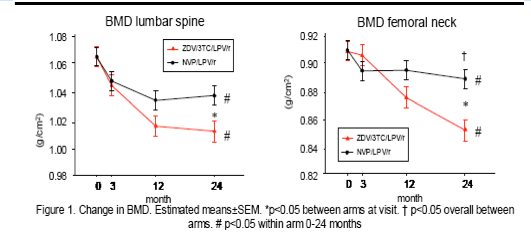
ABSTRACT
Introduction: ART initiation in HIV-infected, antiretroviral-naïve men is associated with loss of bone mineral density (BMD), with greater BMD loss in those randomised to AZT/3TC/LPV/r versus NVP/LPV/r, most evident in the first 12 months of ART (MEDICLAS study). This is accompanied by increases in bone biomarkers, which may offer insights into mechanisms underlying bone loss.
Methods: In the MEDICLAS study, we examined changes in markers of bone resorption (tartrate-resistant acid phosphatase 5b [TRAP5b] and C-terminal telopeptide of type 1 collagen [ß-CTx]) and bone formation (bone-specific alkaline phosphatase [BAP] and procollagen type 1 N propeptide [P1NP]) on stored serum collected at baseline, months 3, 12 and 24. Standardized biomarker values were used to derive bone remodeling balance index (BRBI, [formation-resorption marker]) and bone turnover index (BTI, [(formation+resorption)/2]). Between-group differences were evaluated by mixed model repeated measures analysis with correction for differences in baseline values.
Results: Of 48 male patients (mean [SD] age 42 [10] yrs, 81% Caucasian) 26 were randomised to NVP/LPVr and 22 to AZT/3TC/LPV/r.
Markers of bone resorption significantly increased early after ART initiation in both groups, with greater increases in the AZT/3TC/LPV/r group (ß-CTx P=0.01, TRACP5b P=0.05) and the greatest increases observed by month three;
TRAP5b median [IRQ] +37 [22.5, 66]% with AZT/3TC/LPV/r vs +29 [5, 41]% with NVP/LPV/r, both P<0.0001 and ß-CTx +99 [62, 155]% with AZT/3TC/LPV/r vs 77 [6, 281]% for NVP/LPV/r both Pē0.001.
In contrast, markers of bone formation rose later, with the greatest rises observed at month 12; BAP +60 [33, 89]% for AZT/3TC/LPV/r vs +49 [29, 92]% for NVP/LPV/r, both P<0.0001 and P1NP +76 [38, 150]% for AZT/3TC/LPV/r vs +43 [10, 122]% for NVP/LPV/r, both P<0.01, with no significant between-group differences.
Those with greater increases in BRBI to month 12 experienced greater loss of spine BMD to month 12 (Rho -0.34 to -0.38, all P<0.05). BRBI did not correlate with change in hip BMD and there were no correlations between changes in BTI and BMD at either spine or hip.
Conclusions: Early increases in bone resorption markers, with delayed increases in bone formation markers, represent a catabolic window during which net loss of BMD may occur. These data help explain limited loss of BMD with ART initiation and support short-term bisphosphonate use as anti-resorptive therapy to prevent this early bone loss.
BACKGROUND
Several randomised studies have demonstrated that initiation of antiretroviral therapy (ART) is associated with loss of bone mineral density (BMD), largely confined to the first 12 months of therapy,1-3 and greater reductions observed with ART containing NRTI1 and PI3. Previous studies have demonstrated increases in markers of bone turnover in patients initiating ART. Examining these changes in detail may help explain why loss of BMD with ART initiation is limited to the first 48 weeks of therapy.
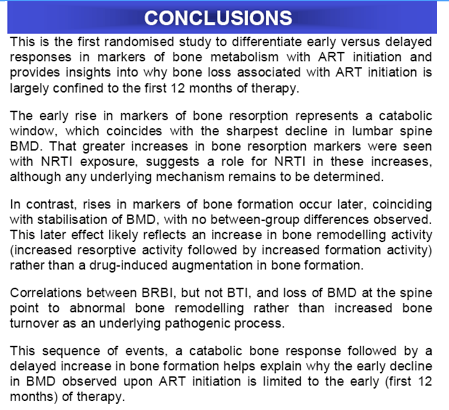
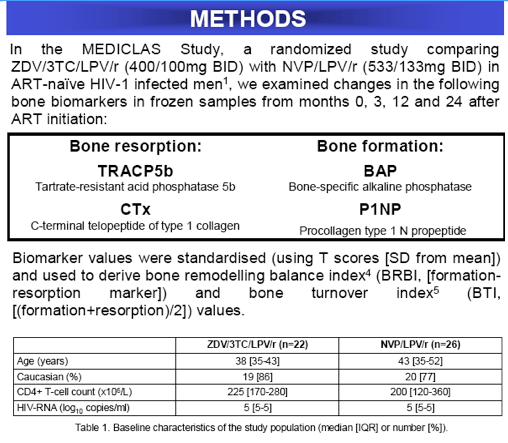
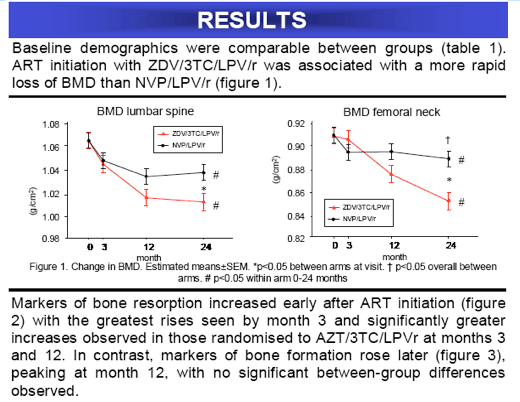
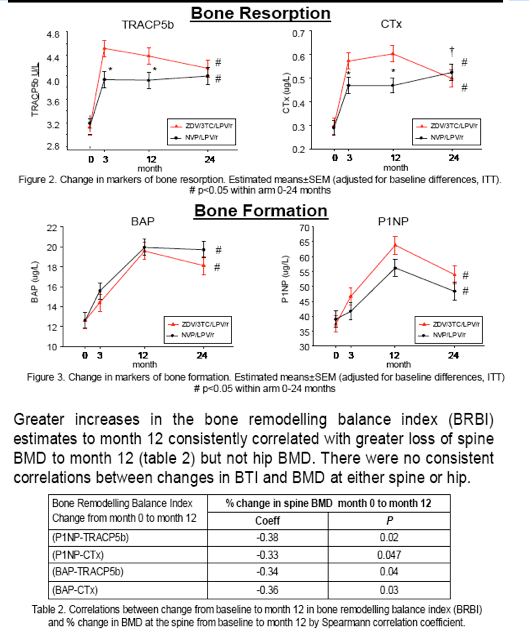
References
1. van Vonderen MG et al. AIDS. 2009 Jul 17;23(11):1367-76.
2. Stellbrink HJ et al. CID 2010 Oct 15; 51(8):963-72.
3. McComsey G et al. CROI 2010; abstract 106LB.
4. Crosbie OM et al. GUT 1999;44:430-434.
5. Waldon-Lynch F et al. Osteoporos Int 2010;21:521-525.
The MEDICLAS study was supported by an independent scientific grant from Abbott International and Boehringer Ingelheim.
PWGM is supported by the Health Research Board (HRA_POR/2010/66)
|
| |
|
 |
 |
|
|